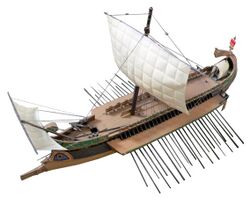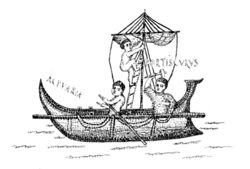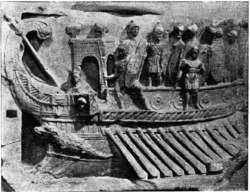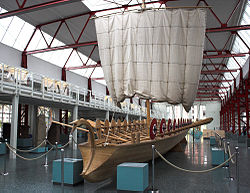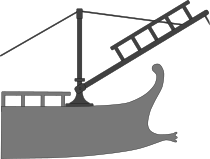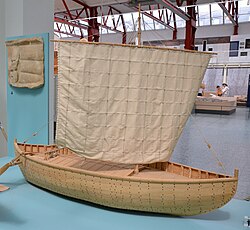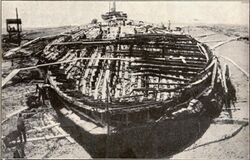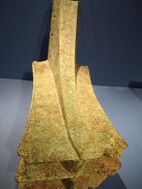Engineering:Ships of ancient Rome
Ancient Rome had a variety of ships that played crucial roles in its military, trade, and transportation activities.[1] Rome was preceded in the use of the sea by other ancient, seafaring civilizations of the Mediterranean. The galley was a long, narrow, highly maneuverable ship powered by oarsmen, sometimes stacked in multiple levels such as biremes or triremes, and many of which also had sails. Initial efforts of the Romans to construct a war fleet were based on copies of Carthaginian warships. In the Punic wars in the mid-third century BCE, the Romans were at first outclassed by Carthage at sea, but by 256 BCE had drawn even and fought the wars to a stalemate. In 55 BCE Julius Caesar used warships and transport ships to invade Britain. Numerous types of transport ships were used to carry foodstuffs or other trade goods around the Mediterranean, many of which did double duty and were pressed into service as warships or troop transports in time of war.
Introduction
Terminology
Roman ships are named in different ways, often in compound expressions with the word navis. These are found in many ancient Roman texts, and named in different ways, such as by the appearance of the ship: for example, navis tecta (covered ship); or by its function, for example: navis mercatoria (commerce ship), or navis praedatoria (plunder ship). Others, like navis frumentaria (grain), navis lapidaria (stones), and navis vivaria (live fish), are about the cargo. The Althiburos mosaic in Tunisia lists many types of ships.[2]
The expression naves longae (lit. "long ships") is the plural of the noun phrase navis longa ("long ship"), following the rules for pluralization of feminine, third declension nouns in Latin, and inflectional agreement of the adjective longus to match.
Scope
In modern historiography, ancient Rome refers to Roman civilization from the founding of the Italian city of Rome in the 8th century BCE to the collapse of the Western Roman Empire in the 5th century CE. It encompasses the Roman Kingdom (753–509 BC), Roman Republic (509–27 BCE), and Roman Empire (27 BCE–476 CE) until the fall of the western empire.[3]
History
Punic wars
The First Punic War between Rome and Carthage began in 264 BC with the Romans landing on Sicily.[4] The Romans had the stronger army, while Carthage had overwhelming maritime superiority.[5] By 260 BC the war had reached a stalemate, as the Carthaginians focused on defending their well-fortified Sicilian towns and cities; these were mostly on the coast and so could be supplied and reinforced without the Romans being able to use their superior army to interdict.[6][7] The focus of the war shifted to the sea, where the Romans had little experience; on the few occasions they had previously felt the need for a naval presence they had usually relied on small squadrons provided by their Latin or Greek allies. Warships of the time were specialised vessels known as galleys and which relied on oars for manoeuvrability.[5][8][9] The Romans set out to construct a war fleet and used a shipwrecked Carthaginian quinquereme as a blueprint for their own.[10] As novice shipwrights, the Romans built copies that were heavier than the Carthaginian vessels, and so slower and less manoeuvrable.[11]
There were repeated naval clashes during the rest of the war, including the 256 BC battle of Ecnomus, possibly the largest naval battle in history by the number of combatants involved.[12][13][14] In 241 BC the Romans destroyed the Carthaginian fleet at the Battle of the Aegates Islands,[15][16] forcing the cut-off Carthaginian troops on Sicily to negotiate for peace and ending the war.[17][18] The Romans and Carthaginians now had rough equivalence in terms of naval strength in the western Mediterranean.[19]
Invasions of Britain
Julius Caesar employed warships and transport ships in order to carry out his invasion of Britain in 55 BCE.
Battle of Actium
Types
The generic Roman term for an oar-driven galley warship was "long ship" (Latin: navis longa, Greek: naus makra), as opposed to the sail-driven navis oneraria (from onus, oneris: burden), a merchant vessel, or the minor craft (navigia minora) like the scapha.[23]
Merchant vessels
The city of Rome was heavily reliant on the delivery by ship of the large amounts of grain it consumed. Rome imported about 150,000 tons of Egyptian grain each year over the first three centuries AD. Not only were insufficient amounts available in the agricultural areas around the city, but it was cheaper to transport it substantial distances by sea than short distances by land. It has been estimated that it cost less for a sailing ship of the Roman Empire to carry grain the length of the Mediterranean than to move the same amount 15 miles by road.[24][lower-alpha 1]
Merchant ships, such as naves onerariae, had always been pressed into service for military purposes such as for transporting troops to North Africa in the Second Punic war.[26] In 204 BCE, Scipio Africanus ordered the impressment of merchantmen for the invasion of Africa, four hundred ships according to Livy.[27](29.26.3)[lower-alpha 2]
Actuaria
An actuaria (short form of navis actuaria, "ship that moves"; plural naves actuariae) was a type of merchant galley used primarily for trade and transport throughout the Roman Empire. The actuaria was equipped with sails as well as oars. It was more expensive to operate than merchant sailing ships, and was used where speed and reliability were a priority. It could carry both passengers and wares such as honey, cheese, meat, and even live animals intended for gladiator combat.[28]
Variants of the actuaria were used as troop transports, for example in the invasion of Britain. In 47 BCE, Publius Vatinius equipped actuariae at Brindisi with temporary rams to support Julius Caesar's forces in Illyricum, on the other side of the Adriatic, though these were only suitable to combat smaller enemy vessels.[28] Actuariae were also employed along the major rivers by Germanicus in his campaigns against the Germanic tribes around 16 AD.[29]
Roman naves onerariae could have up to three square-rigged masts. They depended on the wind and could not leave port on oar power alone, where the more maneuverable galleys could. If winds were not favorable, warping or towing were alternatives.[30] There is some evidence from Claudian in De Bello Gildonico that naves onerariae were in use until late antiquity.[31]
Images of two naves onerariae were pictured in an ancient mosaic floor discovered in Lod, Israel in 1996. Despite damage to the floor, students of maritime history have been able to glean a great deal of information from the images. The ships are of the navis oneraria type, a Roman merchant ship typically displacing 80–150 tons, used to carry such commodities as garum and grain from Egypt to Rome.[32]
Transportation
Corbita
Corbitae were grain ships going back to the Greeks in the 5th c BCE, with loads of around 150 tons. In the first century BCE, they could haul 1300 tons of grain and liquids; the latter in large amphorae. The hulls of the Roman corbitae were ittle changed from the Greek design, and were large, with high sides. Steering was provided via twin steering oars which were very adequate to the task, and not inferior to medieval rudders from later centuries. The oars could be boxed in to the hull with reinforced planking for protection.[33][34]
Obelisk ship
Warships
Bireme
Biremes were typically about 80 feet (24 m) long with a maximum beam width of around 10 feet (3 m).[citation needed]
Liburna
Originally, the liburna was similar to the Ancient Greece penteconter.[37] It had one bench with 25 oars on each side, while in the late Roman Republic, it was equipped with two banks of oars (a bireme), remaining faster, lighter, and more agile than triremes.[37] The liburna design was adopted by the Romans and became a key part of the Roman navy in the second half of the 1st century BCE. Liburnae played a key role in the Battle of Actium in Greece (31 BCE), which saw the establishment of Augustus as the undisputed ruler of the Roman world.[citation needed]
The architecture of the liburna differed from that of the battle triremes, quadriremes and quinqueremes.[37][38] It was 109 ft (33 m) long and 5 m (16 ft) wide with a 1 m (3 ft 3 in) draft. Two rows of oarsmen pulled 18 oars per side. The ship could make up to fourteen knots under sail and more than seven knots under oar power.[39]
After adopting the liburna, the Romans made adaptations to add rams and protection from missiles, in order to improve the ships' use as navy ships. The benefits gained more than made up for the slight loss of speed.[40]
The Romans made use of the liburna particularly within the provinces of the empire, where the ships formed the majority of the fleet,[41][42][43] while it was included in smaller numbers in fleets in Ravenna and Misenum, where a large number of the Illyrians were serving.[citation needed]
A navis lusoria[lower-alpha 4] is a type of a small military vessel of the late Roman Empire that served as a troop transport. It was powered by about thirty soldier-oarsmenand an auxiliary[sail. Nimble, graceful, and of shallow draft, such a vessel was used on northern rivers close to the Limes Germanicus, the Germanic borderlands, and thus saw service on the Rhine and the Danube. Roman historian Ammianus Marcellinus mentioned the navis lusoria in his writings,[45][46] but not much was learned about them until the discovery of such boats at Mainz, Germany in 1981–82.[47]
Olaf Höckmann claimed that the Mainz boats are probably lusoriae, and have some architectural similarity with earlier liburnae. The type A Mainz ships 1 and 7 appear to be identical in form to the ships Ammianus Marcellinus described in his reports on 4th century Rhine battle vessels, and which he always referred to as naves lusioriae.[48] Höckmann finds that ships 1, 4, 7, and 9 are likely lusoriae.[48]
Quinqueremes
Quinqueremes, meaning "five-oared" and indicating that there were five oarsmen per bank of oars, were the first warships the Romans built[49] and provided the workhorse of the Roman fleet throughout the Punic Wars.[50] So ubiquitous was this type of ship that the historian Polybius uses it as a shorthand for "warship" in general.[51] Hexaremes (six oarsmen per bank), quadriremes (four oarsmen per bank) and triremes (three oarsmen per bank) are occasionally mentioned in the sources.[51] A quinquereme carried a crew of 300: 280 oarsmen and 20 deck crew and officers.[52] It would also normally carry a complement of 40 marines – usually soldiers assigned to the ship[53] – if battle was thought to be imminent this would be increased to as many as 120.[54][55]
The quinquereme was a galley, c. 45 metres (150 ft) long, c. 5 metres (16 ft) wide at water level, with its deck standing c. 3 metres (10 ft) above the sea, and displacing around 100 tonnes (110 short tons; 100 long tons). Galley expert John Coates suggested that they could maintain 7 kn (8.1 mph; 13 km/h) for extended periods.[56][page needed] The modern replica galley Olympias has achieved speeds of 8.5 kn (9.8 mph; 15.7 km/h) and cruised at 4 knots (4.6 mph; 7.4 km/h) for hours on end.[49] Average speeds of 5–6 knots (5.8–6.9 mph; 9.3–11.1 km/h) were recorded on contemporary voyages of up to a week.[57]
The generally accepted theory regarding the arrangement of oarsmen in quinqueremes is that there would be sets – or files – of three oars, one above the other, with two oarsmen on each of the two uppermost oars and one on the lower, for a total of five oarsmen per file. This would be repeated down the side of a galley for a total of 28 files on each side; thus 28 x 3 x 2 or 168 oars in total.[58]
Getting the oarsmen to row as a unit, let alone to execute more complex battle maneuvers, required long and arduous training.[59] At least half of the oarsmen would need to have had some experience if the ship was to be handled effectively.[60] As a result, the Romans were initially at a disadvantage against the more experienced Carthaginians. To counter this, the Romans introduced the corvus, a bridge 1.2 metres (4 feet) wide and 11 metres (36 feet) long, with a heavy spike on the underside of the free end, which was designed to pierce and anchor into an enemy ship's deck.[54] This allowed Roman legionaries acting as marines to board enemy ships and capture them, rather than employing the previously traditional tactic of ramming.[61]
All warships were equipped with rams. See details at § Ramming.
Trireme
A trireme was a type of galley with three tiers of oars that was used by the ancient maritime civilizations of the Mediterranean Sea, especially the Phoenicians, Ancient Greece and Romans.[62][63]
Others
- camarae: a flat-hulled, double ended, low freeboard ship from the eastern Black Sea (1st century CE) with 25 to 30 men; could be rowed in either direction[64]
- cybaea – used in Sicily first century BC[64]
- lembus – a small, fast, and maneuverable, light Illyrian warship, capable of carrying 50 men in addition to the rowers. It was the galley used by Illyrian pirates[65]
- moneres – single-row oared vessels[34]
- phaseli – sailing passenger ferries first centuries BCE and CE[64]
- vectoria – passenger ferry second century CE[64]
- Roman penteconter – the name of the Greek penteconter was not romanized for the Roman version of this ship.[34]
Major tactics of naval vessels in combat included physically ramming the enemy boats, brushing alongside with oars retracted to break their oars, or attempting to board them and engage in hand-to-hand combat.
Boarding
The Romans baffled the ramming tactics of the Carthaginians by the invention of the corvus, or crow, a plank with a spike for hooking onto enemy ships which grappled the prow of the rammer, and provided a gangway for boarders.[67] The Romans did continue their boarding tactics in the naval battles of the Punic Wars, but are also reported as ramming the Carthaginian vessels after the abandonment of the corvus. An older and alternative way for boarding was the use of grappling hooks and planks, also a more flexible system than the corvus. Agrippa introduced a weapon with a function similar to the corvus, the harpax.[67]
Ramming
In antiquity, the naval ram was a weapon that dominated Mediterranean naval warfare for nearly five hundred years. The use and devastating force of the ram is evidenced in the ancient sources, but the former weapon was not discovered by archaeologists until the 1980s.[68]
All warships were equipped with rams, a triple set of 60-centimetre-wide (2 ft) bronze blades weighing up to 270 kilograms (600 lb) positioned at the waterline. In the century prior to the Punic Wars, boarding had become increasingly common and ramming had declined, as the larger and heavier vessels adopted in this period lacked the speed and manoeuvrability necessary to ram, while their sturdier construction reduced the ram's effect even in case of a successful attack. The Roman adaptation of the corvus was a continuation of this trend and compensated for their initial disadvantage in ship-manoeuvring skills. The added weight in the prow compromised both the ship's manoeuvrability and its seaworthiness, and in rough sea conditions the corvus became useless.[61][69][70] In 255 BC the Romans lost 384 ships from a fleet of 464 warships off the south-east corner of Sicily, more than 100,000 men were lost.[71][72][73] It is possible that the presence of the corvus made the Roman ships unusually unseaworthy; there is no record of them being used after this disaster.[74][75]
Ramming was done by smashing into the rear or side of an enemy ship, punching a hole in the planking. This did not actually sink an ancient galley unless it was heavily laden with cargo and stores. With a normal load, it was buoyant enough to float even with a breached hull.[76] War galleys gradually began to develop heavier hulls with reinforcing beams at the waterline, where a ram would most likely hit. Besides ramming, breaking enemy oars was also a way to impede mobility and make it easier to drive home a successful ramming attack.[77]
Success in ramming depended so much on a combination of skill and good fortune that it played a somewhat subordinate part in most ancient sea fights. The Romans baffled the ramming tactics of the Carthaginians by the invention of the corvus, or crow, a plank with a spike for hooking onto enemy ships which grappled the prow of the rammer, and provided a gangway for boarders.[67]
Dozens of bronze Carthaginian and Roman rams from the period have been found;[79] see § Punic War rams below.
Shipbuilding
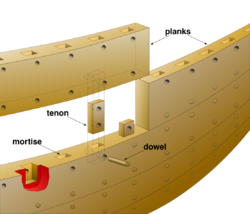
When the Romans first engaged with the Carthaginians, they knew nothing about shipbuilding, and their early war-vessels were merely copies of those used by the Carthaginians, which were of the same general type as the Greek galleys. The first Roman fleet appears to have consisted of quinqueremes.[80]
During the First Punic War, the admiralty of the Roman Republic conceived new and progressive ways of fleet construction, development and composition in order to successfully engage the Carthaginian navy. Victories at the Battle of Mylae, the Battle of Cape Ecnomus, the Battle of Cape Hermaeum and the Battle of the Aegates encouraged the Romans to pursue naval-based warfare and strategies in order to push the center of combat to the Carthaginian heartland in North Africa.[81][82]
Capacity
Large numbers of ships could be constructed in a short time: 600 hundred oared transport ships were built in one winter for Caesar's planned invasion of Britain.[26]
Wrecks and relics
Alkedo
Arles Rhône 3
Blackfriars I
Black Sea
Caligula's Giant Ship
De Meern
From 1997 to 2008, a set of six vessels, consisting of varying states of preservation were discovered in the town of De Meern, Utrecht, Netherlands. Some were utilized as landfill like The De Meern 6, discovered in 2008, but the De Meern 1, first discovered in 1997, and excavated in 2003, was determined to be run aground. The latter was in a good state of preservation with a cabin, and a toolbox. They likely served as transport of the Roman military supply chain in proximity to the Castellums of Laurium and Nigrum Pullum. The De Meern 1 on display at the Museum Hoge Woerd.[85][86][87]
Madrague de Giens
Mainz
Höckmann conjectured that the Mainz boats are probably lusoriae, and have some architectural similarity with earlier liburnae. The type A Mainz ships 1 and 7 appear to be identical in form to the ships Ammianus Marcellinus described in his reports on 4th century Rhine battle vessels, and which he always referred to as naves lusioriae.[48] Höckmann finds that ships 1, 4, 7, and 9 are likely lusoriae.[48]
Marausa
Nemi
Sinop D
Punic War rams
Beginning in 2010 bronze warship rams have been found by archaeologists in the sea off the west coast of Sicily, near where the 241 BC battle of the Aegates is believed to have taken place; as of August 2022, twenty four have been identified, as have ten bronze helmets and hundreds of amphorae.[89][79][90][91] All twenty-four rams, seven of the helmets, and six intact amphorae, along with a number of fragments, have since been recovered.[92] Inscriptions allowed four of the rams to be identified as coming from Roman-built ships.[93] It is possible that some of these had been captured by the Carthaginians earlier in the war and were crewed by them when they were sunk.[94] It is believed that the rams were each attached to a sunken warship when they were deposited on the seabed.[95] Based on the dimensions of the recovered rams, the archaeologists who have studied them believe that they all came from triremes, contrary to Polybius's account of all of the warships involved being quinqueremes.[91][96]
Yassi Ada
Three wrecks near Bodrum, Turkey have been excavated, including a 4th century Roman, and 7th century Byzantine wreck only meters away.[97]
Experimental archaeology
Olympias trireme – 1987
The Olympias trireme is a reconstruction of an ancient Athenian trireme and an important example of experimental archaeology.
Lusoria – 2004
See also
- Ancient maritime history
- Ancient navies and vessels
- History of the Mediterranean region
- List of museum ships
- Maritime archaeology
- Maritime history of Europe
- Roman shipyard of Stifone (Narni)
- Siege of Syracuse (213–212 BC)
References
- Notes
- ↑ The distance by sea from Alexandria (the main Egyptian grain port during the Roman Empire) to Civitavecchia (the modern port for Rome) is 1,142 nautical miles (2,115 km; 1,314 mi).[25]
- ↑ Livy: circum oram omnem maritimam misit ut naves onerariae comprensae Lilybaeum omnes contraheren. Livy 29.24.9
- ↑ The ship shown on the famous so-called in the Prenestine relief kept in the Vatican Museum, dated to the period of Octavian's civil wars, according to some it also shows a liburna. Over time, "liburna" became a general name for various types of Roman ships, and in later antiquity for cargo ships. Tacitus and Suetonius use this name as a synonym for a warship. Suetonius calls the large, lavishly equipped ships, which Emperor Caligula built for his entertainment, deceres liburnae (Suet., Calig., 37). Inscriptions mention the liburna as the last in a class among ancient warships: hexeres, penteres, quadrieres, trieres, liburna.
Lađa prikazana na poznatom tzv. prenestinskom reljefu koji se čuva u Vatikanskom muzeju, datirana u razdoblje Oktavijanovih građanskih ratova, po nekima također prikazuje liburnu. Eijekom vremena "liburna" postaje opći naziv za različite tipove rimskih brodova, a u kasnijoj antici za teretne brodove. Tacit i Svetonije upotrebljavaju to ime kao sinonim za ratni brod. Velike, raskošno opremljene lađe, što ih je sebi za zabavu sagradio ar Kaligula, Svetonije naziva deceres liburnae (Suet., Calig., 37). Natpisi spominju liburnu kao posljendnji u klasi među antičkim ratnim brodovima: hexeres, penteres, quadrieres, trieres, liburna.[44]
- ↑ navis lusoria: from la 'dancing/playful ship', plural naves lusoriae.
- Citations
- ↑ Labate 2017, Conclusion.
- ↑ Carlson 2011, p. 397.
- ↑ EB & Petit 2023, ancient Rome.
- ↑ Lazenby 1996, pp. 48–49.
- ↑ 5.0 5.1 Miles 2011, p. 179.
- ↑ Bagnall 1999, pp. 64–66.
- ↑ Goldsworthy 2006, p. 97.
- ↑ Bagnall 1999, p. 66.
- ↑ Goldsworthy 2006, pp. 91–92, 97.
- ↑ Goldsworthy 2006, pp. 97, 99–100.
- ↑ Murray 2011, p. 69.
- ↑ Goldsworthy 2006, pp. 110–111.
- ↑ Lazenby 1996, p. 87.
- ↑ Tipps 1985, p. 436.
- ↑ Miles 2011, p. 196.
- ↑ Bagnall 1999, p. 96.
- ↑ Lazenby 1996, p. 157.
- ↑ Scullard 2006, p. 565.
- ↑ Collins 1998, p. 13.
- ↑ Gilliver 2003.
- ↑ Rankov 1995, p. 78–80.
- ↑ Rankov 1995, p. 80–85.
- ↑ Saddington 2007, pp. 202–203.
- ↑ Casson 1995, p. 297.
- ↑ "Alexandria - Civitavecchia distance is 1142 NM - SeaRoutes" (in en). https://classic.searoutes.com/routing/4294967629/4294968202?speed=20&panama=true&suez=true&kiel=true&rivers=block&roads=block.
- ↑ 26.0 26.1 Charles 2005, p. 297.
- ↑ Charles 2005, p. 289.
- ↑ 28.0 28.1 Casson 1991, p. 119–123.
- ↑ Viereck 1975, p. 86.
- ↑ Charles 2005, p. 292.
- ↑ Charles 2005, p. 291–292.
- ↑ Friedman 2004, p. 164–168.
- ↑ Denny 2009, p. 21.
- ↑ 34.0 34.1 34.2 Bocquelet 2022.
- ↑ Casson 1995, p. 57–58.
- ↑ Starr 1941, p. 54 et seq..
- ↑ 37.0 37.1 37.2 Starr 1941, p. 54.
- ↑ Zaninović 1988, pp. 46–47.
- ↑ Gabriel 2007, pp. 36–43.
- ↑ Morrison & Coates 2016, pp. 170, 317.
- ↑ Casson 1971, p. 141.
- ↑ Morrison & Coates 2016, p. 171.
- ↑ Starr 1941, p. 54ff.
- ↑ 44.0 44.1 Zaninović 1988, p. 47.
- ↑ Ammianus & Yonge 1862, 2-§12.
- ↑ Bierweiler-Regensburg.
- ↑ 47.0 47.1 Höckmann 1993.
- ↑ 48.0 48.1 48.2 48.3 Höckmann 1993, p. 131.
- ↑ 49.0 49.1 Goldsworthy 2006, p. 98.
- ↑ Lazenby 1996, pp. 27–28.
- ↑ 51.0 51.1 Goldsworthy 2006, p. 104.
- ↑ Goldsworthy 2006, p. 100.
- ↑ Tipps 1985, p. 435.
- ↑ 54.0 54.1 Casson 1995b, p. 121.
- ↑ Goldsworthy 2006, pp. 102–103.
- ↑ Coates 1995, p. 138.
- ↑ Casson 1995, p. 283.
- ↑ Casson 1995, p. 101.
- ↑ Casson 1995b, pp. 278–280.
- ↑ de Souza 2008, p. 358.
- ↑ 61.0 61.1 Miles 2011, p. 178.
- ↑ Coates 2000, pp. 127–230.
- ↑ Welsh 1988.
- ↑ 64.0 64.1 64.2 64.3 Pitassi 2011, p. 180.
- ↑ Wilkes 1995, p. 157, 163.
- ↑ Morrison, Coates & Rankov 2000, p. 48–49.
- ↑ DeCasien 2019.
- ↑ Wallinga 1956, pp. 77–90.
- ↑ Goldsworthy 2006, pp. 100–101, 103.
- ↑ Goldsworthy 2006, p. 115.
- ↑ Tipps 1985, p. 438.
- ↑ Miles 2011, p. 189.
- ↑ Scullard 2006, p. 557.
- ↑ Lazenby 1996, pp. 112, 117.
- ↑ Casson 1991, p. 139.
- ↑ Coates 1995, p. 133.
- ↑ Hocker 1995, pp. 86–100.
- ↑ 79.0 79.1 Tusa & Royal 2012, p. 12.
- ↑ Holmes 1906, p. 36.
- ↑ Casson 1995, p. 105.
- ↑ Tusa & Royal 2012.
- ↑ 83.0 83.1 HeritageGateway 2012.
- ↑ Brennan 2011.
- ↑ van Holk 2011.
- ↑ Hoge Woerd 2018.
- ↑ "De Meern 6 | MaSS". https://mass.cultureelerfgoed.nl/de-meern-6.
- ↑ Curry 2012, p. 37.
- ↑ RPM Foundation 2020.
- ↑ Prag 2013.
- ↑ 91.0 91.1 Murray 2019.
- ↑ Tusa & Royal 2012, pp. 12, 26, 31–32.
- ↑ Tusa & Royal 2012, p. 18.
- ↑ Tusa & Royal 2012, p. 45.
- ↑ Tusa & Royal 2012, p. 39.
- ↑ Tusa & Royal 2012, pp. 39–42.
- ↑ Bass & van Doorninck 1971, p. 27.
- ↑ Bass & van Doorninck 1971, p. 27–29.
Works cited
- Ammianus Marcellinus (1862). "2". Res Gestae. Book XVIII. London: Bohn. § 12. https://www.tertullian.org/fathers/ammianus_18_book18.htm#C2. Retrieved 29 July 2023.
Template:ReflibTemplate:Sfn whitelist
- Bass, George F.; van Doorninck, Frederick H. (1971). "A Fourth-Century Shipwreck at Yassi Ada". American Journal of Archaeology 75 (1): 27–37. doi:10.2307/503679. https://www.jstor.org/stable/503679.
- Bierweiler, Jan. "Verein der Freunde der Alten Geschichte e.V. – Hintergrund der naves lusoriae" (in de). Universität Regensberg, Der Verein Römerschiff. http://www.uni-regensburg.de/Fakultaeten/phil_Fak_III/Geschichte/Alte_G/VEFAG/hintergr_04.html.
- Brennan, Michael L.; Ballard, Robert D.; Croff Bell, Katherine L.; Piechota, Dennis (2011). "Archaeological oceanography and environmental characterization of shipwrecks in the Black Sea". in Buynevich, Ilya V.; Yanko-Hombach, Valentina; Gilbert, Allan S. et al.. Geology and Geoarchaeology of the Black Sea Region: Beyond the Flood Hypothesis. Special Papers. 473. Geological Society of America. doi:10.1130/2011.2473(11). ISBN 978-0-8137-2473-7. https://pubs.geoscienceworld.org/books/book/631/chapter/3806061. Retrieved 30 November 2023.
- Bocquelet, David (2022-10-24). "Roman Ships – From SPQR to the Imperium". https://naval-encyclopedia.com/antique-ships/roman-ships.
- Casson, Lionel (1971). Ships and Seamanship in the Ancient World. Princeton University Press. ISBN 9780691035369. OCLC 141594. https://books.google.com/books?id=sDpMh0gK2OUC.
- Casson, Lionel (December 1, 1995). Ships and Seamanship in the Ancient World. Baltimore: The Johns Hopkins University Press. ISBN 978-0-8018-5130-8. OCLC 32549371. https://books.google.com/books?id=sDpMh0gK2OUC.
Template:ReflibTemplate:Sfn whitelistTemplate:Cite whitelink
- Collins, Roger (1998). Spain: An Oxford Archaeological Guide. Oxford: Oxford University Press. ISBN 978-0-19-285300-4.Template:ReflibTemplate:Sfn whitelist
- DeCasien, Stephen (2019). "Naval Ram Collection". https://shiplib.org/index.php/rams-2/.
- Denny, Mark (2009). Float Your Boat!: The Evolution and Science of Sailing. Baltimore: Johns Hopkins University Press. ISBN 9780801890093. OCLC 214066711. https://books.google.com/books?id=Rtg6T9kMZkUC&pg=PT34.
- Petit, Paul; Hornblower, Simon; Ferguson, John (9 November 2023). "ancient Rome" (in en). Encyclopædia Britannica. https://www.britannica.com/place/ancient-Rome. Retrieved 29 November 2023.
- Frere, Sheppard Sunderland (1987). Britannia: A History of Roman Britain (3rd ed.). Routledge & Kegan Paul. ISBN 978-0-7102-1215-3. https://books.google.com/books?id=9209AAAAIAAJ.
- Friedman, Zazara (2004). "The Ships Depicted in the Lod Mosaic Reconsidered". International Journal of Nautical Archaeology (Portsmouth: The Nautical Archaeology Trust Ltd) 33 (1): 164–168. doi:10.1111/j.1095-9270.2004.0015b.x.
- Gabriel, Richard A. (2007). "The Roman Navy: Masters of the Mediterranean". Military History 29 (9): 36–43. https://www.historynet.com/the-roman-navy-masters-of-the-mediterranean.htm.
- Gilliver, Catherine (2003). Caesar's Gallic wars, 58–50 BC. New York: Routledge. ISBN 978-0-203-49484-4. OCLC 57577646. https://books.google.com/books?id=O1xsBgAAQBAJ.
Template:ReflibTemplate:Sfn whitelist
- "Blackfriars Ship I". 2012. https://www.heritagegateway.org.uk/Gateway/Results_Single.aspx?uid=405065&resourceID=19191.
- Holmes, Sir George Charles Vincent (1906). Ancient and Modern Ships. Victoria and Albert Museum science handbook. H. M. Stationery Office. OCLC 5268420. https://www.google.com/search?tbm=bks&q=B-EwAQAAMAAJ.
- "Ship and limes" (in en-US). 12 November 2018. https://www.museumhogewoerd.nl/en/discover/ship-and-limes/.
- Höckmann, Olaf (May 1993). "Late Roman Rhine vessels from Mainz, Germany". International Journal of Nautical Archaeology (Wiley) 22 (2): 125–135. doi:10.1111/j.1095-9270.1993.tb00401.x. ISSN 1095-9270. https://onlinelibrary.wiley.com/doi/abs/10.1111/j.1095-9270.1993.tb00401.x.
- Labate, Victor (6 March 2017). "Roman Shipbuilding & Navigation". World History Encyclopedia. World History Publishing. https://www.worldhistory.org/article/1028/roman-shipbuilding--navigation/. Retrieved 12 July 2023.
Template:Sfn whitelistTemplate:Cite whitelink
- Murray, William M. (2019). "The Ship Classes of the Egadi Rams and Polybius' Account of the First Punic War". https://classicalstudies.org/annual-meeting/145/abstract/ship-classes-egadi-rams-and-polybius’-account-first-punic-war.
- Pitassi, Michael (2011). Roman Warships. Woodbridge, Suffolk: Boydell Press. ISBN 9781843836100. OCLC 646110784. https://books.google.com/books?id=7Wie8Vn5-cMC&pg=PA180.
- Pliny the Elder (1855). "14. Obelisks" (in en). The Natural History. 7, Book 36. London: Taylor and Francis. OCLC 1377782773. http://data.perseus.org/citations/urn:cts:latinLit:phi0978.phi001.perseus-eng1:36.14.Template:ReflibTemplate:Sfn whitelist
- "Battle of the Egadi Islands Project". RPM Nautical Foundation. 2020. https://rpmnautical.org/projects/egadi-islands-project/.
Template:ReflibTemplate:Sfn whitelist
- Scullard, H.H. (2006). "Carthage and Rome". in Walbank, F. W.; Astin, A. E.; Frederiksen, M. W. et al.. Cambridge Ancient History: Volume 7, Part 2, 2nd Edition. Cambridge: Cambridge University Press. pp. 486–569. ISBN 978-0-521-23446-7.
- de Souza, Philip (2008). "Naval Forces". in Sabin, Philip; van Wees, Hans; Whitby, Michael. The Cambridge History of Greek and Roman Warfare, Volume 1: Greece, the Hellenistic World and the Rise of Rome. Cambridge: Cambridge University Press. pp. 357–367. ISBN 978-0-521-85779-6.
- Starr, Chester G. (1941). The Roman Imperial Navy 31 B.C. – A.D. 324. Ithaca, NY: Cornell University Press. https://books.google.com/books?id=4awKxgEACAAJ.
- Tipps, G.K. (1985). "The Battle of Ecnomus". Historia: Zeitschrift für Alte Geschichte 34 (4): 432–465.
- Tusa, Sebastiano; Royal, Jeffrey (2012). "The landscape of the naval battle at the Egadi Islands (241 B.C.)" (in Italian, English). Journal of Roman Archaeology (Cambridge University Press) 25: 7–48. doi:10.1017/S1047759400001124. ISSN 1047-7594. https://www.journalofromanarch.com/samples/v25.Royal.pdf.
- van Holk, André (2011). "2 - Recent Research on Roman Shipfinds from the Netherlands". in Boetto, Giulia; Pomey, Patrice; Tchernia, André. Batellerie gallo-romaine:Pratiques régionales et influences maritimes méditerranéennes. Bibliothèque d’archéologie méditerranéenne et africaine, 9 (New (online) ed.). Aix-en-Provence: Publications du Centre Camille Jullian, Éditions Érrance. doi:10.4000/books.pccj.967. ISBN 9782957155781. http://dx.doi.org/10.4000/books.pccj.967.
- Viereck, Hans D. L (1975) (in de). Die römische Flotte: Classis Romana. Herford, Germany: Koehler. ISBN 378220106X. OCLC 2318792. https://books.google.com/books?id=0YjfAAAAMAAJ.
- Wallinga, Herman (1956). The Boarding-bridge of the Romans: Its Construction and its Function in the Naval Tactics of the First Punic War. Groningen: J.B. Wolters. OCLC 458845955.
Template:ReflibTemplate:Sfn whitelist
- Wilkes, John J. (1 December 1995). The Illyrians (The Peoples of Europe). Oxford: Blackwell. ISBN 9780631198079. OCLC 36173200. https://books.google.com/books?id=4Nv6SPRKqs8C.
- Zaninović, M. (1988). "Liburnia Militaris". Opusc. Archeol. 13: 43–67. https://hrcak.srce.hr/5311.
Further reading
- Blaschke, Jayme (23 June 2008). "Tide and time: Re-dating Caesar's invasion of Britain". Texas State University. http://www.txstate.edu/news/news_releases/news_archive/2008/06/Caesar062308.html.
- Chatterton, Edward Keble (2010). The history of sailing ships the story of their development from the earliest times until the 19th century. Historische Schiffahrt, 150. Bremen: Salzwasser. p. 107. ISBN 9783861953081. OCLC 845685916. https://books.google.com/books?id=KF2JEAAAQBAJ&pg=PA107.
- D'Amato, Raffaele (2015). Republican Roman Warships 509–27 BC. New Vanguard, vol. 225. Illustrated by Giuseppe Rava. Bloomsbury. ISBN 9781472808295. https://books.google.com/books?id=-Z2ICwAAQBAJ.
- Dreyer, Boris (March 2011). "Principles and Progress in the Shipbuilding Part of the EU Interreg DTP Project 'Living Danube Limes.'" (in en). Építés - Építészettudomány [Architectonics and Architecture] (AK Journals) 49 (1–2): 171–208. doi:10.1556/096.2021.00008.
- Günther, Sven; Ruffing, Kai; Stoll, Oliver (2007) (in de). Pragmata: Beiträge zur Wirtschaftsgeschichte der Antike im Gedenken an Harald Winkel. Philippika, 17. Wiesbaden: Harrassowitz. ISBN 9783447055369. OCLC 153885180. https://books.google.com/books?id=4_yu9f_eZP4C&pg=PA29.
- Ermatinger, James William (11 August 2015). The World of Ancient Rome: A Daily Life Encyclopedia. Santa Barbara: Greenwood. p. 725. ISBN 9781440829079. OCLC 1440829071. https://books.google.com/books?id=9rI6CgAAQBAJ&pg=PA725.
- Emil Luebeck: "Actuariae". In: Realencyclopädie der classischen Altertumswissenschaft (RE). Volume I, 1, Stuttgart 1893, p. 331.
- Meijer, Fik A History of Seafaring in the Classical World
- Pitassi, Michael The Roman Navy: Ships, Men and Warfare 350 BC–AD 475
- Starr, Chester (1991). A History of the Ancient World. New York, New York: Oxford University Press. ISBN 978-0-19-506628-9.
- Steinby, Christa Rome versus Carthage
- Torr, Cecil Ancient Ships
External links
 |
